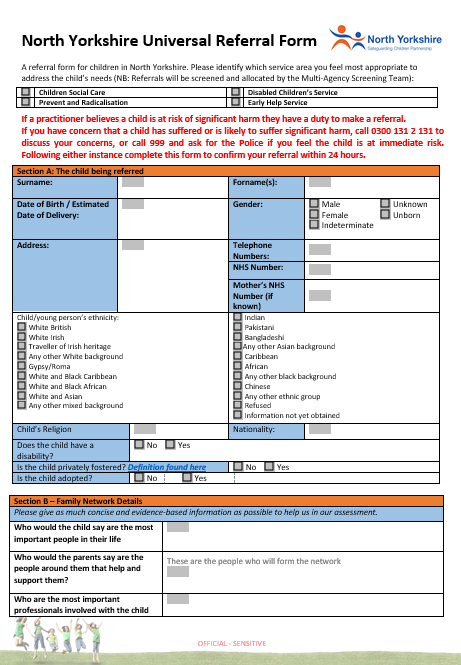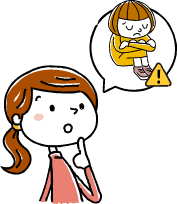Using the Children and Families Universal Referral Form
Summary
The NYSCP Universal Referral Form reflects North Yorkshire Council’s Strength in Relationship Model, which is underpinned by Systemic Working and Practice and use of Signs of Safety (SofS) to make decisions about contacts in a timely and consistent manner. The questions asked within the Universal Referral Form assists Children and Families Service to obtain a better understanding of that child’s situation, including what the worries are, the strengths and safety for that child and referrers analysis of the situation. Please see below a breakdown of the Universal Referral Form to:
- understand what each section means of the form means, and
- what to consider ensure the Children and Families Service have the information they need to allocate the correct level of support at the right time to make a positive impact for the child and their family.
Before you begin
- Talk to the family first unless doing so would place any person at a risk of harm – a family cannot make changes if they do not know your concerns or changes which you feel need to be made
- Be honest and factual – information shared in your referral will form the basis for decision-making and be shared with the family, it can be challenging to gain a clear understanding of the situation or request for support if the information provided is vague or generalised
- Take your time – consider how you would want information about your own family to be recorded and consider what your best hopes from a Children and Families Service Referral is (referrals should not be made “just in case” or “to pass on info”)
- Talk to anyone who is already involved – if there is a Child and Family Worker, please call them first unless there is an immediate safeguarding concern
- If you feel a child is at immediate risk call the Police on 999
- You should also consider whether you need to refer your concerns to the police via the Partnership Information Sharing Form, for more information please visit:
Referral content
Section A: The child being referred
This section includes basic details about the child being referred. It is important as much information about this child is included in the referral, including whether the child is privately fostered.
Section B: Family network details
It is important to gather as much information about who is around the child as this forms the child’s network and who will be involved in safety planning. Consider asking the child and parents who would form their network. Communication needs should explain the best ways to communicate with the child and their family, considering the language spoken at home, any speech or language difficulties or other factors which could influence how a child or family should be communicated with.
Section C: Worries
Within this section of the referral you are being asked questions to help best understand your worries for the child. Include a clear description of the worry or incident e.g. if there is an injury or mark add a detailed description of what you see, have heard or observed. Consider answering the below questions when completing a referral:
- How often is the worry happening i.e. once a week or 3 times over 2 years?
- When was the worry at its worse and what was happening them?
- When was the first time you saw this worry?
- When was the last time you saw this worry?
- What is the impact on the child or family?
- What will things look like if nothing changes?
Section D: Strengths and Safety
This is the section where you provide detail about what is working well for the family. For all our families there are strengths in their lives and in their network, this section is helping agencies to identify these strengths from the very beginning.
When filling out this section, consider when there have been difficulties:
- Who have you and the family spoken to for assistance?
- Who would the child say they want you to speak to?
Section E: Analysis and judgement
This is where you analyse your information and indicate what your best hopes from a referral to Children and Families are. You will be asked to scale where you think the current worries are:
- 0 is where we think a child has been or is being seriously hurt, and
- 10 is where there are no more needs for this child than any other in the local community and there are people around making sure the child is OK.
Scaling assists in measuring progress over time and it is vital you indicate your scaling and the rationale for this figure through highlighting why scale is not higher and what needs to happen to increase the figure. Be clear on what you feel needs to happen next:
- What are your best hopes are for making a referral to Children and Families Service.
- What do you want for the family?
- What would life look like for this child if things were different?
Section F: Details of any children and adults within the child’s life
Use this section to record detail of the child’s family network, ensuring to include details of the non-resident parent.
Section G: Consent
It is good practice that professionals work in partnership with parents and carers to effect positive change. Therefore, it is important that parent and carers are informed of a professionals concerns, and consent is obtained for sharing their personal information with Children and Families Service.
It is important to understand what the parents/carers views are of the referral and what support they would like to access. Consent is required for referrals to services such as Early Help and without it, the services available to the family may be limited. There are some occasions when consent is not required, including: If it places the child/young person at significant harm, or could delay support. In these situations, it is important you record the reasons for not seeking consent.
Where consent has not been obtained and professionals feels that after speaking with their safeguarding lead/manager that a referral is still warranted, professional should submit a referral detailing this conversations and inform parent and carer of their actions and reasons. A professional cannot remain anonymous when making a referral, transparency with families and carers is important and is needed to ensure successful and positive interventions
Section H: Services working with the family
It is important all relevant professionals and their best contacts numbers/email is recorded within this section. Professionals listed will also form the network around the child and family.
Section I: Referrers details
Please provide the best way to contact you and how best to share the outcome of the referral with you i.e. direct email or to a team email address. If you are on the leave immediately following submission of the referral, please provide details of an alternative professional should MAST need to seek additional information in respect of your referral.
What will happen after you have made a referral?
Once your referral is submitted via telephone or email, this will be handled by the Customer Service Centre (CSC) who will notify you when your referral has been successfully received. If you do not receive an acknowledgement of receipt of referral, please contact the CSC to clarify they have received it. The CSC will log your concerns on to the electronic Children and Families System and pass this to the Multi Agency Screening Team (MAST) for review and screening.
If you have an urgent concern outside of normal office hours, you should contact the Emergency Duty Team on 0300 131 2 131.
The MAST will review your referral using of Signs of Safety to make decisions about contacts in a timely and consistent manner. Appropriate and proportionate multi-agency information is shared, using professional judgement and guided by the Continuum of Need to decide on the best outcome for child and family referral. The MAST will contact families or referrers as part of this screening process where appropriate, to ensure decisions are made collaboratively.
The outcome of contacts are threefold:
- The child does not appear to be a Child In Need, which will result in either:
- the provision of information or advice
- sign-posting to another agency, and/or
- no further action.
- Allocation of the case to Early Help Support;
- An assessment being undertake by the area safeguarding team as the child appears to be a Child in Need or it is suspected that the child is suffering or is likely to suffer from Significant Harm.
A decision on the contact will be made within one working day of your contact being received. If the referrer is a professional or hold’s Parental Responsibility for the child, they will be notified of the outcome of your contact by the team where the piece of work has been allocated or by the MAST if it has been identified there is no further role for the Children and Families Service.
To follow up the outcome of your referral or if you disagree with an outcome please contact the Customer Service Centre on 0300 131 2 131 for information or speak with the MAST professional who screened the contact with the details provided on the referral response email.






 View all our news
View all our news